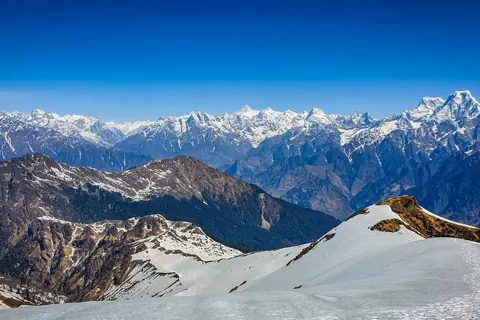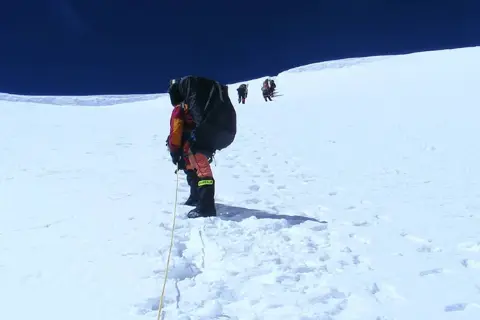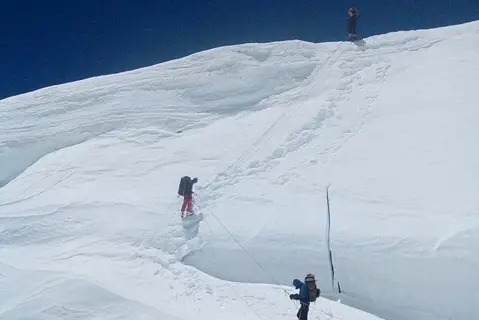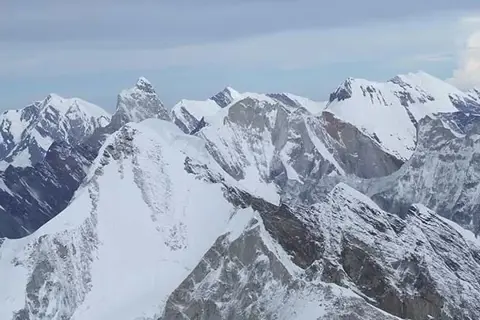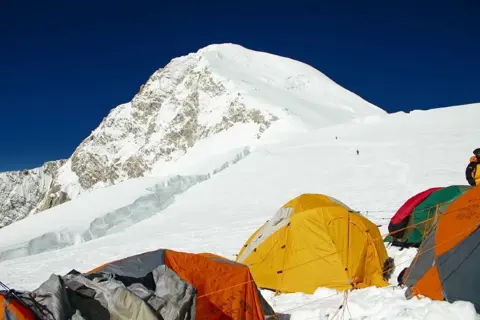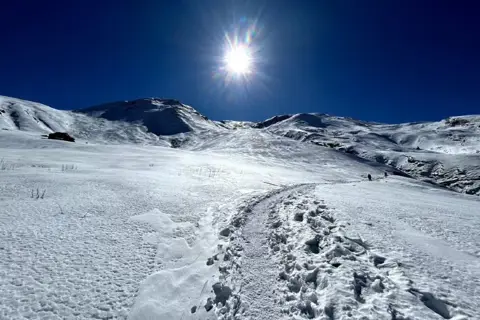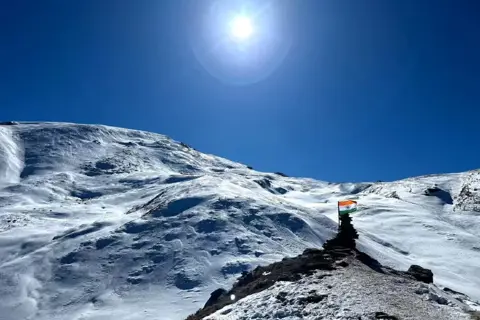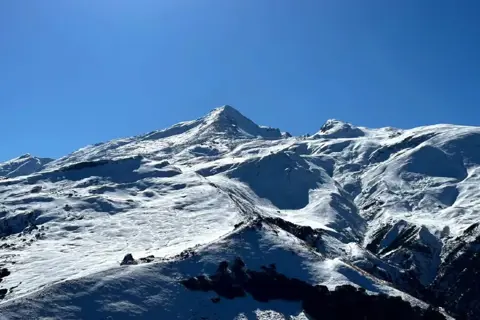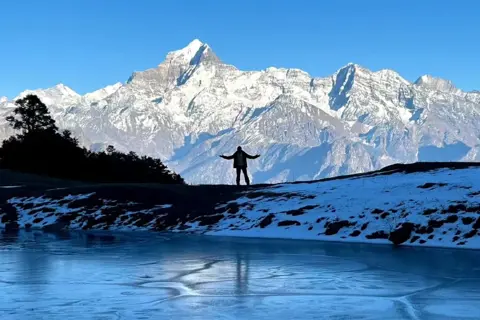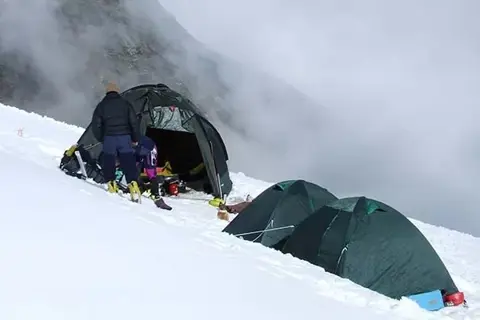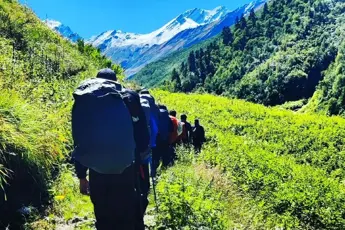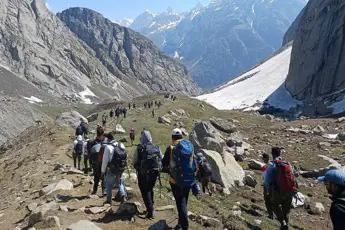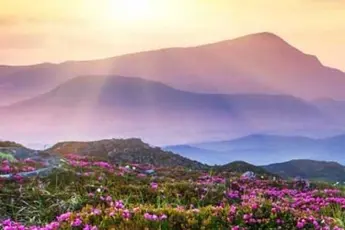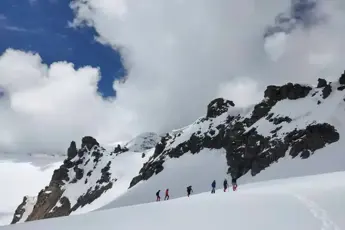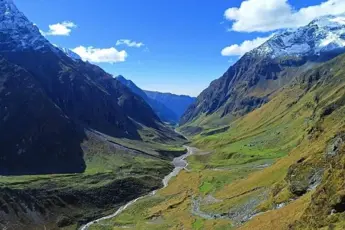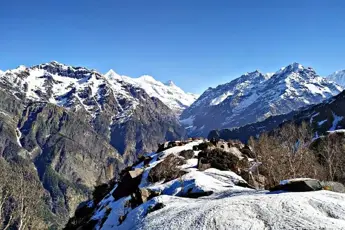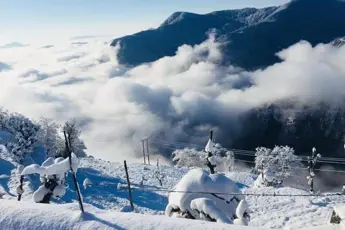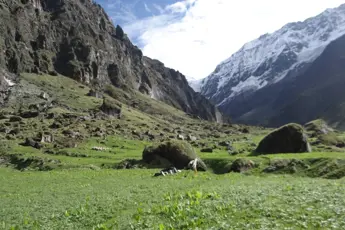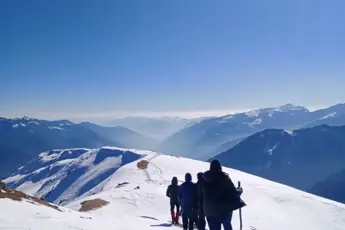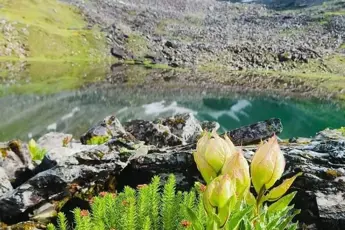Mt. Kamet, very tall at 7,756 meters (25,446 ft), is the second-tallest peak in the Garhwal Himalayas of Uttarakhand, India, next to Nanda Devi. Known for its huge look and tough climbs, Kamet is a top pick for climbers who want to take on a big mountain but not over 8,000 meters. It stands with big peaks like Mukut Parbat, Abi Gamin, and Mana Peak, and together they make a huge showy group along the India–Tibet line. The trip to Kamet is a true test of how long you can last, your skill, and your will. Not like many other big hills, the climb up Kamet means crossing ice, steep ice walls, deep open cracks, and very thin tops that ask for much strength and know-how. The path mostly goes by the East Kamet Ice flow, with high camps set more and more at 5,400m, 6,400m, and 7,100m before the last push to the top.Thin air, bitter cold, and wild weather up the stakes, making it a rush for tough climbers. Even though it's far out, you can get to Kamet from Joshimath in Uttarakhand by way of the Dhauli Ganga valley. The walk to get there is great, taking climbers over high meadows, ice piles, and high passes. The view has great looks at big peaks like Nanda Devi, Chaukhamba, and Trishuli. For climbers, going up Kamet is not just about winning a peak; it's about feeling the wild power of the Himalayas and seeing how far people can push. The climb mixes thrill, soul, and the beauty of nature, making it one of the most worth-it climbs in India. Getting to the top feels like a big win for any climber, and stands for guts, going on, and love for the hills.History of Mt. Kamet ExpeditionMt. Kamet has a big place in the story of going through the Himalayas and climbing. Close to the Tibetan Plateau, Kamet was one of the first tall peaks that caught the eye for its big size and sharp top. For ages, it was a mystery, held up in old tales and loved by locals. It’s being near the old Indo-Tibet trade ways made it also big in role and feel. First notes of going up Kamet go back to the mid-19th century during the Great Finds about India's Land. Map-makers marked and checked the Garhwal Himalayas, and Kamet was a tough one that seemed nearly too hard because of its rough land and being so far away. Some early goers tried to find ways, but did not get far. Real tries to climb Kamet began in the early 1900s. In 1907, a team from Britain led by C.F. Meade tried but had to turn back because the north ways were too hard. More teams in 1911 and 1913 tried to, but could not go far.The big win came in 1931, when a team from Britain led by Frank Smythe, with R.L. Holdsworth and Eric Shipton, took a smart way. They went up by the East Kamet Ice flow, set camps, and on June 21, 1931, they made it. They were the first to climb over 7,600 meters. This win was big then, as it opened new doors in high-hill climbing and set the stage for even taller climbs, like those over 8,000 meters. The 1931 climb made Kamet a legend in climbing tales. Frank Smythe wrote a lot about it, pushing more climbers and stirring those who dream of adventures far and wide. Since then, Kamet has had more wins by both Indian and world climbers, though it's less walked than peaks like Everest or Kanchenjunga. Its out-of-the-way spot, hard walk, and tough climb keep it a respected and big goal even now. Kamet is also big in soul for Garhwal folks. They see it as a home of holy power. This mix of spirit, past tales, and thrill makes Kamet more than just a mountain—it is a living mark of the forever big feel of the Himalayas.Nearby Places to Mt. Kamet ExpeditionJoshimath: Joshimath sits at the foot of the Garhwal Himalayas and opens the way to the Kamet trip. This lively, small town is famous for both spirit and adventure. It has old temples like the Adi Shankaracharya Math, and it is the first step to holy trips to Badrinath and Hemkund Sahib. For those who hike or climb, Joshimath is the last big spot for food, gear, and papers before they go into the high, cold wild.Badrinath Temple: This key holy site of Hinduism, Badrinath Temple, is about 45 km from Joshimath. It honours Lord Vishnu and is one of the Char Dham trip spots in India, set among the great Himalayan peaks. Many who climb or visit Kamet also come to get blessings here, before or after their hard trip.Mana Village: Seen as India's last village by the Indo-Tibetan border, Mana is very close to Badrinath. It's a place full of culture where guests can see old Himalayan life and tales. Spots like Bheem Pul (a stone bridge) and Vyas Gufa (a cave from the Mahabharata story) show their deep myths.Valley of Flowers: Near Joshimath is the well-known Valley of Flowers National Park, a UNESCO World Heritage Site. Famous for its fields full of flowers, it's a dream spot for hikers, plant lovers, and picture takers. Going to this valley offers a calm break from the tough Kamet area, showing a softer side of the Himalayas.Nanda Devi National Park: Close to Kamet is the Nanda Devi Biosphere Reserve, filled with different plants, animals, and snowy views. This safe area is known for its wild beauty and amazing sights of Nanda Devi, India’s second-highest peak. For those who love nature and open land, this park gives a memorable Himalayan time.Auli: Near Joshimath, Auli is India's top ski place. With oak woods and snowy peaks like Nanda Devi and Trishul around, Auli has fun like skiing, cable car rides, and pretty hikes. For those mixing trips with fun, Auli is a great stop before or after the Kamet trip.Best Time to Visit Mt. Kamet ExpeditionPre-Monsoon Season (May – June): May and June are the best months to try the Mt. Kamet trip. In these times, the snow settles, and the weather stays more stable, with clear skies and not-too-cold air up high. Climbers will find hard snow and ice, good for setting up camps and tough climbs. The paths are also easier to walk before the big rains start.Post-Monsoon Season (September – October): The next good time for the Kamet trip is from September to October, after the rains. This time gives clear views, with sharp mountain looks and fewer sudden storms. Paths and ice get safer, though it gets much colder, especially in high spots. This time is good for climbers who can deal with the cold.Winter Season (November – February): Winters are very cold in the Kamet area, with lots of snow, very low temperatures, and hard-to-reach places. Trips are not suggested now as paths are blocked, and there is a big risk of snowslides. Still, the area draws those who trek in winter and take photos, coming to the nearby valleys for snowy sights and icy beauty.Monsoon Season (July – August): The rainy months are the worst time for the Kamet trip. Lots of rain makes rivers big, leads to falling rocks, and makes paths and climbs very hard. Clouds also block the view, and non-stop rain makes snow spots less stable, upping the chance of bad events. Most trips don't pick this season.How to Reach Mt. Kamet ExpeditionBy Airport: The closest airport to Mt. Kamet is Jolly Grant Airport in Dehradun, about 270 km from Joshimath, the start of the trip. Regular planes fly between Dehradun and big places like Delhi, Mumbai, and Bangalore. From Dehradun, one can take a taxi or bus to Joshimath, the door to the trip.By Railway Station: The nearest big train stop is Haridwar Railway Station, about 290 km from Joshimath. Haridwar links well with Delhi, Lucknow, Kolkata, and other big cities in India. From Haridwar, guests go on to Joshimath by road by taxi, jeep, or bus. Another choice is Rishikesh Railway Station, a bit closer but with fewer long-trip train links than Haridwar.By Road: Joshimath, the start for the Mt. Kamet trip, links well by road to key towns in Uttarakhand. Buses and private taxis are ready from Dehradun, Haridwar, and Rishikesh. The drive to Joshimath is pretty, past the Alaknanda River through mountain roads, going by towns like Srinagar, Rudraprayag, and Chamoli. From Joshimath, hikers go on to the base camp in the Dhauli Ganga Valley, with help from mules or porters to carry trip loads.Why Book with escape2exploreWhen exploring the Mt. Kamet Expedition and beyond, escape2explore stands out as a trusted name in adventure and experiential travel. Here’s why hundreds of travellers choose us for their getaways:Trusted, Well-Reviewed Local Operator: escape2explore has gained the trust of thousands of content tourists all over India. With persistent positive feedback and an unblemished reputation for delivering quality experiences, we assure you that your experience will be hassle-free, memorable, and value-packed. Our insider local knowledge guarantees that you will always be in safe hands.Seasoned Guides: Our trips are led by friendly, trained, and professional guides who are passionate about the outdoors and your safety. Whether it's a beach trek, a cultural tour, or a spiritual walk through temples, our team knows the terrain, the stories, and how to make each moment count.Safe & Curated Itineraries: Your safety is our number one priority. Our tour packages are thoughtfully crafted with safety measures, researched accommodations, and easy travel arrangements. We take care of the details so you can have the experience hassle-free and worry-free.Unique Experience That You Won't Find Anywhere Else: With escape2explore, you discover more than the tourist attractions. We go off the beaten track with hidden beaches, unusual treks, offbeat cultural destinations, and true interactions.







